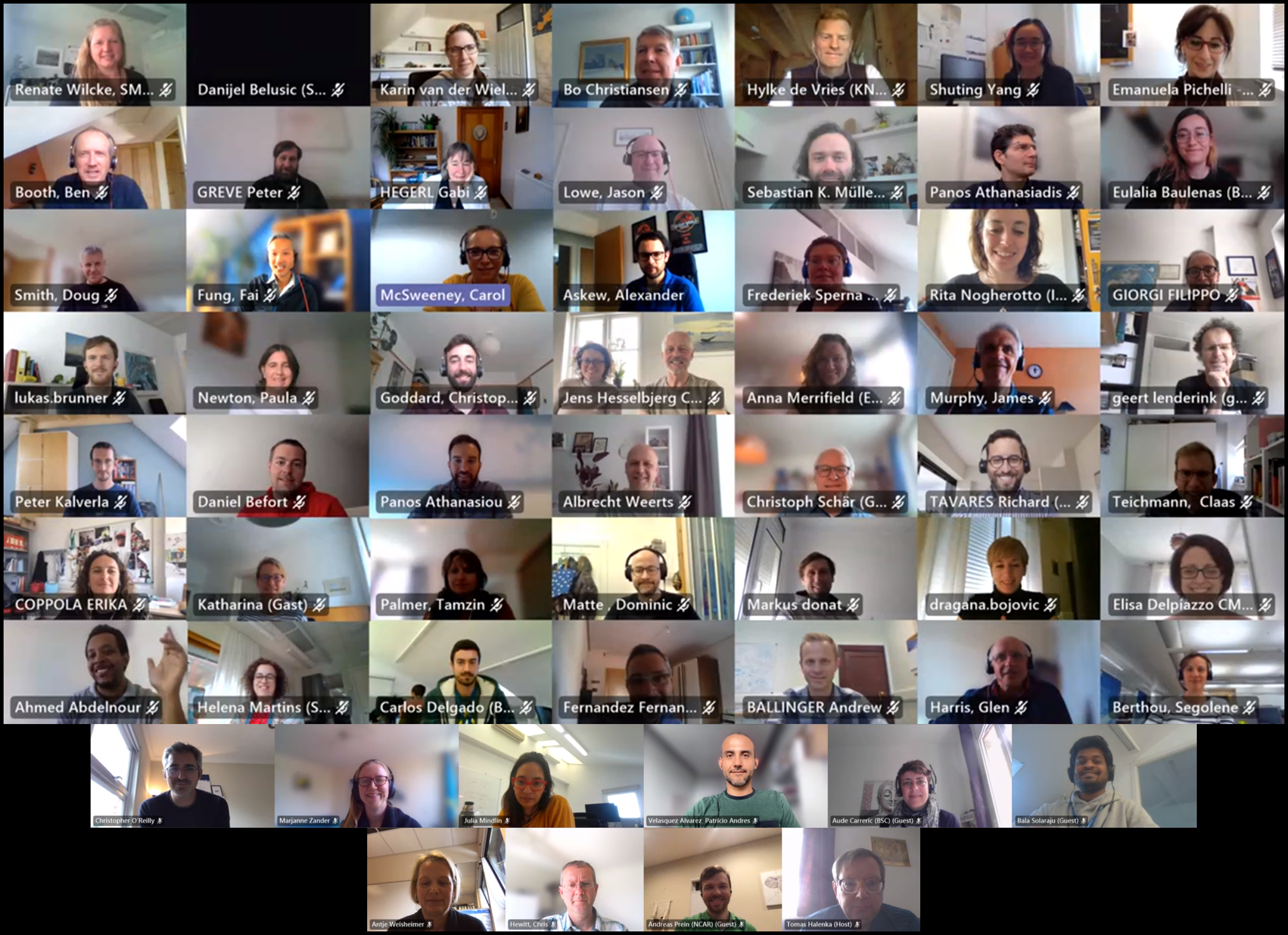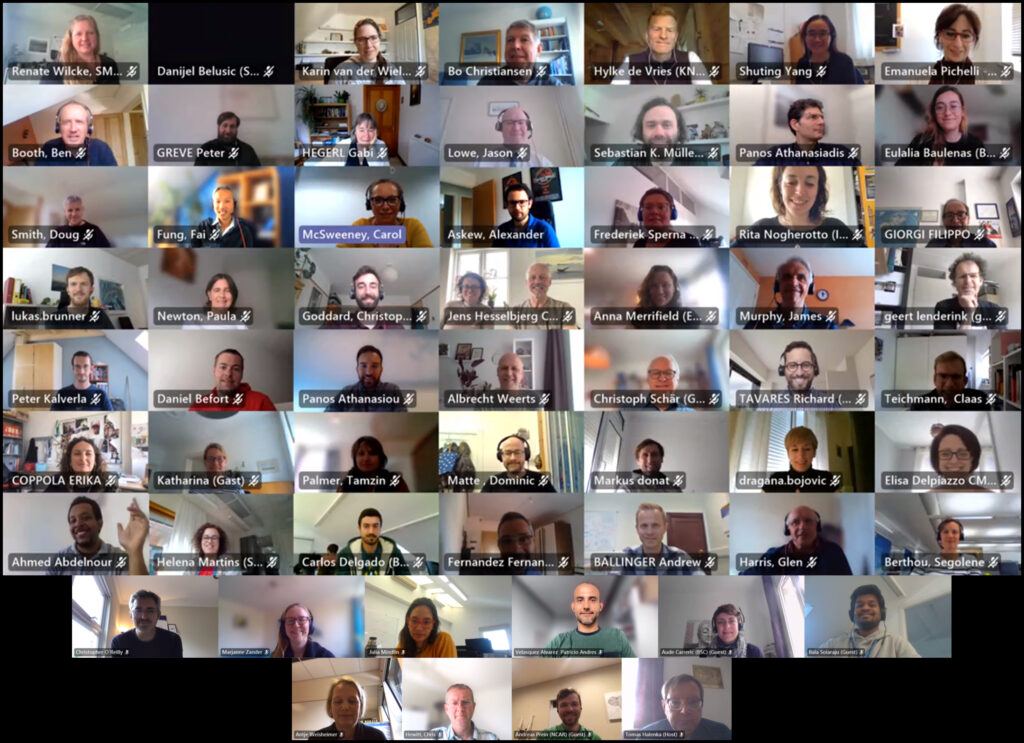Our final meeting in EUCP (4th – 6th May 2022) was a chance to see all our colleagues again and share the last 4 ½ years of progress and advances under the EUCP project. The meeting was very well-attended, with a peak of over 100 delegates joining us. This first day was set to focus on work done largely under Work Packages 2 and 5 on regional climate ensemble projections, followed by EUCP’s key products, but before that the meeting was opened by the Met Office’s Prof. Jason Lowe OBE.
Jason began by thanking everyone present for their efforts at making EUCP a success over the last 5 years plus, from proposal to today. He highlighted the work towards each of EUCP’s core objectives: (i) producing new and improved information to support climate adaptation; (ii) improving and using decadal climate predictions; (iii) extracting better information from longer-term climate projections; (iv) obtaining seamless climate information for simulations of 1-40 years in the future; and (v) better simulating future local extreme weather, using high-resolution models that were just starting to be used when the project began. This has come at the same time as adapting to new work practices under the COVID-19 pandemic which has involved many successful online events, including meetings of the Multi-User Forum and a dedicated session at the EGU conference in 2020. EUCP has also built up a significant profile through communications initiatives and user interaction.
The first session of the meeting focussed on getting more information from ensemble climate projections (usually running up to 40 years in the future) for regional climate contexts.
Ben Booth began with an overview of why we constrain regional climate projections and what we have learnt about the process. Challenges still remain, including whether constraint gives consistent insights on future climate change, whether constraint adds value and whether we can screen out poor models. Ben described how different methods of constraint applied to Europe have different strengths and weaknesses, and how they tend to improve the reliability of temperature projections, but not rainfall. The recent Sixth Assessment Report from the IPCC has highlighted the emerging need to explore and apply constraints, and EUCP science lays down important groundwork for future assessments. The team has made much of their findings and code available, including through the EUCP Atlas.
Lukas Brunner introduced us to his work on moving towards a unified method of constraining climate projections on a European scale. Ideas from the world of weather forecasting have been used to help decide what makes a good projection in terms of information and usefulness. EUCP has developed a brand-new framework for comparing different methods of projection constraint, including combinations of methods. The team focussed on making this new framework consistent, inclusive of all methods, unambiguous and easy to apply. This is a key part of EUCP’s contribution to developing more consistent projection constraints for the European region and globally.
We then heard from Chris O’Reilly on his team’s new method of testing observational constraints on future European climate in an out-of-sample framework. This involves testing methods of constraining older CMIP5 model data, with newer CMIP6 data used in place of observations to test the methods’ effectiveness. All methods were found to provide useful constraint, particularly for temperature, with no one stand-out best option. Indeed, a multi-method approach was often the most valuable strategy.
Frederiek Sperna Weiland from Deltares then told us about her team’s work on using performance-based model weighting to assess the impact of climate change on European river basins. Their weighting strategy allows them to obtain a more robust signal of climate change from the projections, particularly where the signal is stronger. The team projected a marked reduction in minimum river flow in southern Europe, thanks to decreased summer rainfall and higher evaporation. In northern Europe however, earlier snow melt leads to increased minimum river flow. Results for changes in average and maximum flows are more mixed, but still significant for certain rivers.
Chris Goddard provided an overview of EUCP’s work on climate storylines. Storylines are useful for bringing many strands of scientific enquiry together into a unified story. Stakeholders see value in this endeavour, particularly in the co-production process with scientists, developing an output according to their needs. Several challenges remain, however, mostly around the need to maintain a well-defined brief for the project, avoiding over-generalisation and too broad an overview of future climate, which can lose useful detail.
We then heard from Dominic Matte on a storyline he has worked on around the flooding that hit Copenhagen in 2011. This was described as the strongest cloudburst ever recorded in Copenhagen and caused an estimated 6 billion krone in damage. The team has shown that a high-resolution, convection-permitting climate model can capture the key features of this extreme event. Although the simulation isn’t perfect, it can reveal a reasonably accurate location and a possible severity for the event, which is more than was forecast at the time. The team also showed that the risk of seeing rainfall as high as this has increased as the climate has warmed and is set to increase further with additional warming. Indeed, the city of Copenhagen has since taken steps to prevent impacts on this scale from future events.
The panel discussion at the end of this first session revisited many of the main points raised earlier in the day:
- The panel discussed the need to maintain co-production of climate storylines with users in order to avoid pitfalls such as over-interpretation of their results.
- In discussing the difficulties of constraining rainfall projections, their usefulness in impact modelling was mentioned, but they are not yet ready for this application. Various ideas were suggested for how this problem may be tackled in future work.
- When looking at the consistency of constraint results at different scales, it is key to consider the drivers of change, and whether they are local or large-scale.
- Users are often interested in reasonable ‘worst-case’ scenarios of future climate impacts, but can these be confidently obtained from constrained projections and storylines? It is important in this case to define what a reasonable worst case is and what factors and techniques can be used to produce one.
- Finally, the panel discussed the issue of models underestimating changes in atmospheric circulation, and whether this would appear in a storyline application. The team at KNMI have run several scenarios of storylines, however their methodology stops them from assessing issues around circulation. The problem of communicating this shortcoming to users was highlighted.
The final talk of the day from Peter Kalverla highlighted the many useful products that have come out of EUCP. Peter highlighted how engaging users is key to making EUCP science effective in society and how the EUCP storyboard platform helps put our work into the hands of more people in an accessible form. Peter also highlighted the new EUCP data catalogue, which provides a valuable, accessible directory of important datasets and visualisations underpinning the work of EUCP.
See also Part 2 and Part 3 of this report for more on our Final Meeting.





 Funded by the European Union under Horizon 2020.
Funded by the European Union under Horizon 2020.